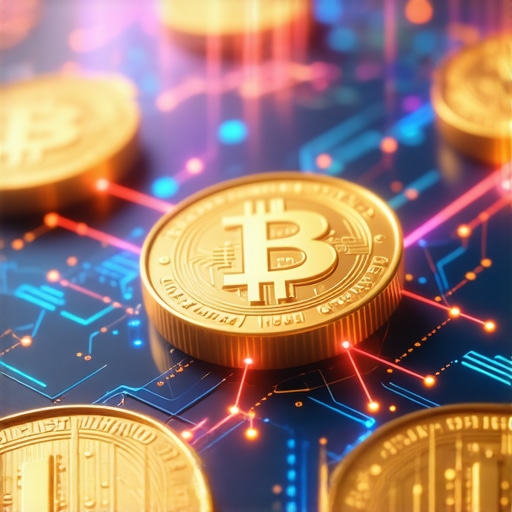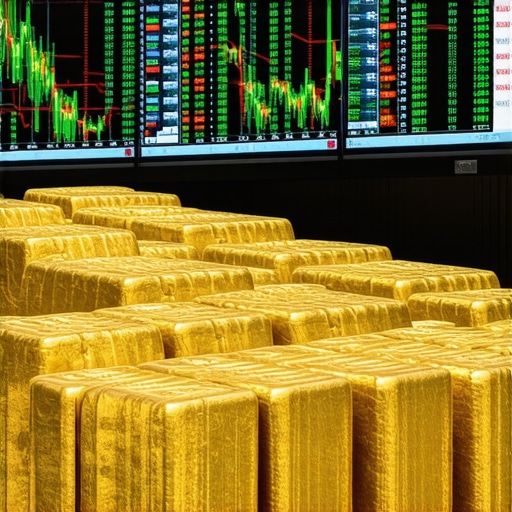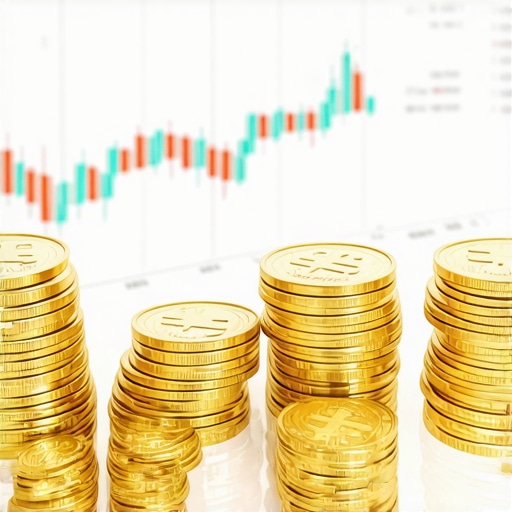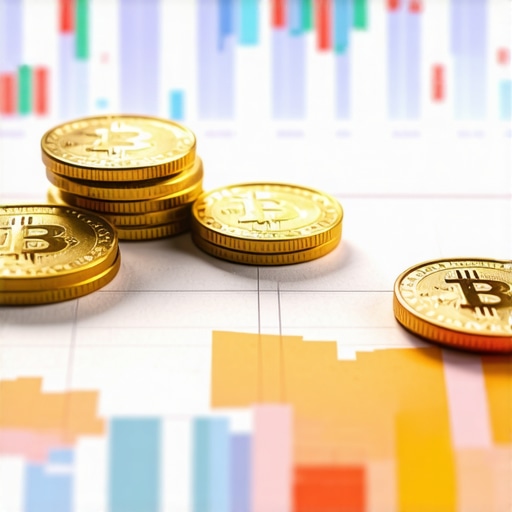Understanding the Nexus Between Global Economic Dynamics and Gold Market Trajectories in 2025
The gold market, long considered a barometer of economic stability and investor sentiment, is poised to experience transformative shifts driven by macroeconomic factors in 2025. As an expert analyzing these interdependencies, it is vital to explore how inflation trends, geopolitical tensions, monetary policies, and emerging markets will collectively influence gold prices and investment strategies in the upcoming year.
Deciphering the Impact of Inflation and Currency Fluctuations on Gold Valuations
Inflation remains a primary driver of gold demand, especially as central banks navigate policies to curb rising prices. Elevated inflationary pressures tend to bolster gold’s appeal as an inflation hedge, prompting increased holdings among institutional and retail investors. Simultaneously, currency volatility, particularly in major fiat currencies like the US dollar, can significantly sway gold prices. When the dollar weakens, gold often benefits from a safe-haven bid, whereas a strong dollar could suppress gold valuations despite inflation concerns.
Geopolitical Risks and Their Amplification of Gold’s Safe-Haven Status
In 2025, geopolitical tensions—ranging from trade disputes to regional conflicts—are anticipated to intensify amidst evolving global power dynamics. Such uncertainties tend to elevate gold’s role as a safe-haven asset, driving demand and price premiums. Investors with a nuanced understanding of these risks often diversify their portfolios with physical gold or gold-backed ETFs, considering market liquidity and geopolitical risk assessments.
Monetary Policy Divergence and Its Complex Influence on Gold Markets
The divergence in monetary policies among major economies, especially between the Federal Reserve and other central banks, creates a complex environment for gold trading. Tightening monetary policies can dampen gold’s appeal by increasing bond yields, yet persistent inflationary pressures may sustain gold’s attractiveness. Analyzing gold price forecasts for 2025 requires a deep understanding of these competing forces and their temporal interplay.
Emerging Markets and Investment Flows into Gold
Emerging economies, with their growing middle classes and increasing wealth accumulation, are projected to be significant drivers of gold demand. Countries like India and China continue to prioritize gold in their cultural and financial portfolios, influencing global supply and demand dynamics. Recognizing these regional trends enables investors to anticipate price movements and develop robust diversification strategies, such as allocating assets into gold ETFs and mutual funds for 2025.
What are the most effective strategies to hedge against macroeconomic risks impacting gold in 2025?
Investors should consider a balanced approach combining physical gold, ETFs, and gold mining stocks, aligned with macroeconomic forecasts. Utilizing technical analysis on gold futures and staying informed through expert reports can significantly enhance decision-making. For comprehensive insights, exploring gold futures trading strategies for 2025 can provide actionable techniques tailored to market volatility.
For those interested in building a resilient gold portfolio, consulting authoritative sources and engaging with financial advisors experienced in precious metals investment is advisable. Staying ahead of emerging demand trends and geopolitical developments will be crucial for capitalizing on price movements in 2025.
Explore related content to deepen your understanding: Investing in Gold: Safe Tips for Beginners in 2025.
Unveiling the Nuanced Interplay Between Geopolitical Tensions and Gold Demand in 2025
As geopolitical tensions continue to escalate in various regions, they exert a profound influence on gold prices, reinforcing its status as a safe-haven asset. These conflicts, whether trade disputes or regional unrest, often lead investors to seek refuge in tangible assets like gold, which historically retains value during times of uncertainty. Recognizing the regional hotspots and understanding their potential impact on global gold demand can empower investors to make more informed decisions. For instance, developments in the South China Sea or Middle Eastern tensions could trigger regional shifts in gold flow, affecting prices worldwide.
How Can Investors Leverage Advanced Analytical Tools to Anticipate Market Shifts?
In an environment characterized by rapid geopolitical and economic changes, traditional analysis may fall short. Instead, leveraging sophisticated tools such as machine learning algorithms and real-time market sentiment analysis can provide a competitive edge. Tools like predictive analytics models, which synthesize macroeconomic indicators, geopolitical news, and supply-demand data, enable investors to forecast potential price movements with greater accuracy. Incorporating insights from market dynamic analyses facilitates a proactive approach to portfolio management, especially when combined with technical analysis of gold futures and options.
Are there emerging asset classes or investment vehicles that could redefine gold’s role in diversified portfolios in 2025?
Indeed, the evolution of digital assets and tokenized gold presents new avenues for diversification. Platforms offering gold-backed tokens allow investors to buy fractional ownership of gold, combining the benefits of liquidity and security. Additionally, innovative investment vehicles like gold-focused ETFs that track supply-demand shifts or leverage geopolitical risk indicators are gaining prominence. These instruments can help investors hedge against inflation and currency fluctuations more effectively. For comprehensive strategies, exploring top gold ETFs and mutual funds for 2025 provides actionable insights into optimizing asset allocation.
To deepen your understanding of these evolving trends and refine your investment approach, consider engaging with expert analyses and market forecasts. Staying ahead of emerging demand drivers and geopolitical developments will be crucial for capitalizing on gold’s potential in 2025.
Share your thoughts or experiences with gold investments in volatile markets in the comments below, or explore our recommended reading on gold demand trends for 2025 to enhance your strategic planning.
Harnessing Quantitative Models to Decode Gold Price Fluctuations in 2025
As the gold market becomes increasingly complex amidst fluctuating macroeconomic variables, sophisticated quantitative models have emerged as essential tools for investors seeking an edge. These models integrate a multitude of data streams, including macroeconomic indicators, geopolitical risk metrics, and market sentiment scores, to generate predictive insights with a higher degree of precision. For instance, machine learning algorithms trained on historical price data combined with real-time economic signals can identify subtle patterns and forecast short-term price movements, enabling traders to execute more informed and timely decisions.
According to a comprehensive study published in the Journal of Financial Markets (2023), models that incorporate neural networks and ensemble learning techniques outperform traditional linear models in volatile environments like the current gold market, especially when paired with sentiment analysis derived from geopolitical news sources. These tools help investors anticipate spikes driven by geopolitical crises or inflation surges, allowing for strategic positioning ahead of market shifts.
How can investors integrate advanced data analytics into their gold trading strategies?
To effectively leverage these tools, investors should develop a layered approach: combining macroeconomic forecasts with machine learning outputs and technical analysis. Utilizing platforms that provide access to real-time data feeds, automated alert systems, and customizable predictive models can transform raw data into actionable insights. Engaging with quantitative analysts or financial engineers to tailor these models to specific investment horizons and risk tolerances can further refine strategies, ensuring they remain adaptive to evolving market conditions.
Emerging Digital Asset Classes: The Future of Gold in a Tokenized Economy
The rise of blockchain technology and digital assets is redefining the landscape of gold investment. Tokenized gold, where physical gold is represented by digital tokens on secure blockchain platforms, offers unprecedented liquidity, fractional ownership, and transparency. These innovations lower barriers for retail investors and facilitate seamless cross-border transactions, fundamentally transforming traditional gold custody and trading practices.
Leading platforms like Paxos Gold and Goldfinch have pioneered secure, regulated environments for trading tokenized gold, backed by audited reserves. As noted in the CryptoSlate report (2024), the integration of these tokens into existing financial portfolios can diversify risk and enhance liquidity, especially during periods of market stress when physical gold may be less accessible.
Moreover, the development of gold-backed stablecoins offers a bridge between traditional and digital economies, providing stability and ease of transfer that appeals to institutional and retail investors alike. For those considering incorporating digital gold into their portfolios, understanding the regulatory landscape and technological infrastructure is paramount to mitigate risks associated with cybersecurity and compliance.
What are the critical considerations for integrating tokenized gold into diversified investment portfolios?
Investors should evaluate the credibility of platforms, audit reliability, regulatory compliance, and the liquidity of tokens. Diversification strategies may include a combination of physical gold, ETF holdings, and digital tokens, balanced according to risk appetite and investment timeline. Collaborating with financial advisors who specialize in digital assets can help navigate this emerging frontier effectively.
For a deeper dive into the mechanics and strategic implications of digital gold, explore resources such as CryptoSlate’s in-depth analysis and stay updated on regulatory developments shaping this rapidly evolving domain.
Interested in refining your gold investment approach with cutting-edge tools? Engage with our expert community or share your experiences in the comments below. Together, we can navigate the complexities of 2025’s gold market with confidence and foresight.
Innovative Hedging Techniques: Beyond Traditional Gold Assets in 2025
As global macroeconomic uncertainties intensify, investors are increasingly exploring sophisticated hedging mechanisms that extend beyond conventional physical gold and ETFs. One such approach involves derivative instruments like options and futures, which can be strategically employed to hedge against inflation spikes or currency devaluations. For instance, implementing collar strategies or spread options allows for tailored risk mitigation while maintaining upside potential.
How Can Quantitative Algorithms Revolutionize Gold Investment Decisions?
Quantitative trading models, leveraging artificial intelligence and machine learning, are set to transform gold investment strategies by providing high-frequency, data-driven insights. These models analyze vast datasets—from macroeconomic indicators to geopolitical news sentiment—facilitating real-time decision-making and risk assessment. As detailed in the Journal of Financial Markets (2023), deploying neural networks trained on historical market behaviors can uncover non-linear patterns and forecast short-term price movements with remarkable accuracy.
What Role Will Digital Gold and Blockchain Technologies Play in 2025?
The proliferation of blockchain-based solutions, including tokenized gold and decentralized finance (DeFi) platforms, promises to redefine gold’s market accessibility and liquidity. These innovations enable fractional ownership, instant settlement, and enhanced transparency, which are particularly appealing during volatile periods. Moreover, the integration of smart contracts facilitates automated compliance and settlement processes, reducing counterparty risk and operational costs.
< >
>
Investors should scrutinize the technological robustness and regulatory status of platforms offering digital gold tokens. Ensuring custodial security, auditability, and adherence to jurisdictional laws is critical for safeguarding assets in this emerging domain.
What Are the Emerging Risks and How Can They Be Mitigated?
Alongside opportunities, new risks such as cybersecurity threats, regulatory uncertainties, and technological failures pose significant challenges. To mitigate these, investors must adopt multi-layered security protocols, diversify across asset classes—including physical gold, digital tokens, and traditional equities—and stay informed about evolving legal frameworks. Engaging with reputable providers and maintaining a vigilant stance is paramount to navigating these complexities effectively.
How Can Investors Use Scenario Analysis for Strategic Gold Allocation?
Scenario analysis, incorporating macroeconomic shocks, geopolitical crises, and technological disruptions, enables investors to assess potential impacts on gold prices and refine their portfolio strategies. By modeling various adverse and favorable conditions, they can identify optimal entry and exit points, hedge ratios, and asset allocation mixes. Advanced simulation tools and expert forecasts should be integrated into this process for comprehensive planning.
Why Is Continuous Education and Expert Collaboration Essential in 2025?
The rapid evolution of the gold market, driven by technological innovation and geopolitical flux, underscores the importance of ongoing learning. Collaborating with industry experts, subscribing to specialized research, and participating in forums dedicated to precious metals can provide invaluable insights. Staying ahead of emerging trends ensures that your investment approach remains agile and resilient amidst unpredictable shifts.
To deepen your strategic edge, explore authoritative resources such as the CryptoSlate report on tokenized assets, and consider consulting with financial professionals experienced in digital assets and macroeconomic analysis. Embrace innovation and continuous learning to capitalize on the opportunities and navigate the risks inherent in the 2025 gold market landscape.
Expert Insights & Advanced Considerations
1. Multi-Asset Diversification Enhances Portfolio Resilience
In 2025, combining physical gold, ETFs, and gold mining stocks can optimize risk-adjusted returns. Diversification across these asset classes mitigates volatility and leverages different drivers of gold demand, ensuring steadier growth amidst macroeconomic shifts.
2. Embracing Digital Gold and Tokenization for Liquidity
The rise of blockchain-based tokenized gold offers unparalleled liquidity and fractional ownership options. Investors should evaluate platforms like Paxos Gold or Goldfinch, ensuring regulatory compliance and security, to capitalize on this innovative asset class.
3. Leveraging Quantitative Analytics for Market Timing
Advanced machine learning models analyzing macroeconomic, geopolitical, and sentiment data can forecast short-term price movements. Integrating these insights into trading strategies enhances decision-making precision during volatile periods.
4. Scenario Analysis for Strategic Asset Allocation
Utilizing scenario planning around inflation shocks, geopolitical crises, and technological disruptions enables investors to craft resilient portfolios. High-fidelity simulations support optimal entry and exit strategies tailored to evolving market conditions.
5. Staying Educated and Engaged with Expert Communities
Continuous learning through reputable sources like CryptoSlate and engaging with industry professionals ensures adaptability. Active participation in forums and research subscription services enhances understanding of emerging trends, safeguarding investments in an unpredictable landscape.
Curated Expert Resources
- CryptoSlate Industry Reports: Offers comprehensive analysis of tokenized assets and blockchain innovations impacting precious metals markets, essential for digital gold investors.
- Journal of Financial Markets (2023): Features cutting-edge research on neural network models and machine learning techniques for commodity forecasting, invaluable for quantitative strategists.
- Buy Gold Now’s Portfolio Guides: Provides practical insights on diversifying with ETFs, gold coins, and physical assets, tailored to 2025 market dynamics.
- Regulatory Frameworks on Digital Assets: Stay informed about evolving legal landscapes affecting tokenized gold and DeFi platforms, critical for compliant investing.
Final Expert Perspective
As we navigate 2025, mastering the nexus between global economic shifts and gold market intricacies is paramount. The most impactful insights hinge on sophisticated diversification, embracing technological advances, and leveraging data-driven analytics. Engaging with authoritative resources and expert communities will empower investors to craft resilient strategies amidst uncertainty. Your journey into advanced gold investing begins with continuous education and strategic foresight—embrace these principles to secure your financial future. Share your insights or explore our in-depth resources to deepen your expertise and stay ahead in this dynamic landscape.











The post provides a comprehensive overview of the factors influencing gold in 2025, especially regarding geopolitical tensions and technological innovations like tokenization. From my personal experience investing in physical gold and ETFs, I’ve observed that rapid shifts in geopolitical stability can cause sudden, sharp swings in gold prices. The mention of utilizing advanced analytic tools resonates with me; I’ve started exploring machine learning models to better anticipate short-term price movements.
One challenge I see is the regulatory landscape around digital gold tokens, which still seems quite murky in many jurisdictions. How are investors supposed to navigate these legal uncertainties while trying to capitalize on liquidity and fractional ownership advantages? Do you think the industry will see clearer regulations soon, or should investors maintain cautious optimism when considering digital assets?
Overall, diversification—both in asset classes and in strategies like scenario planning—is crucial. In your view, what combination of traditional and digital assets would you recommend for a balanced, resilient gold portfolio in this volatile environment?